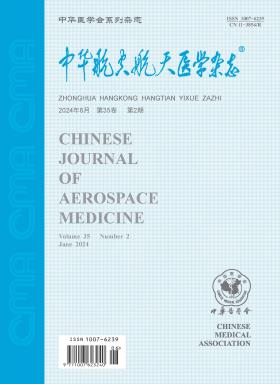Application of real-time shear wave elastography on the diagnosis of thyroid nodules in pilots
引用次数: 0
Abstract
Objective To explore the effects of real-time shear wave elastography (SWE) on diagnosing benign and malignant thyroid nodules in pilots. Methods Fifty-two pilots were diagnosed as thyroid nodules (60 nodules) in 456th Hospital of People′s Liberation Army from May 2014 to May 2017. They were checked by real-time shear wave elastography and the Young's moduli of nodules and normal thyroid tissues were recorded. The Young's modulus of patients′ normal thyroid tissues was taken as control value and was compared to that of thyroid nodules. By referring to the pathological examination result as the gold stand, the receiver operating characteristic (ROC) curve was plotted to determine if the thyroid nodules were benign or malignant in SWE diagnosis. The area under the ROC curve (AUC) was compared to determine the best diagnostic boundary. Results Out of 52 cases of thyroid nodules, 43 cases (48 nodules) were benign lesions. The pathological types included nodular goiter (n=33) and adenomas (n=15). There were 9 cases of malignant lesions (12 nodules) including papillary carcinoma (n=10) and small papillary carcinoma (n=2). The maximum, average and minimum Young′s modulus values showed significant difference between control group and those with thyroid adenoma, nodular goiter and thyroid malignant tumor (F=258.19, 268.39, 421.84, P<0.01). The mean, maximum and minimum Young′s modulus values of malignant nodules were (58.68±9.27) kPa, (78.64±11.53) kPa and (38.51±5.81) kPa respectively, and were higher than those of benign thyroid nodules (41.48±5.69) kPa, (52.23±7.71) kPa, (31.51±2.47) kPa. The differences had statistical significance (t=8.16, 9.55, 6.44, P<0.01). The AUC corresponding to the maximum, average and minimum Young′s modulus value was 0.929, 0.863 and 0.798 respectively. The best diagnostic efficiency was at the maximum Young′s modulus in the nodule and its diagnostic threshold was 54.42 kPa. Conclusions The Young′s modulus of benign thyroid nodules is smaller than that of malignant nodules in pilots. Applying the maximum value of the Young′s modulus enables better diagnosis accuracy than using its average or minimum value in determining malignant thyroid nodules. The quantitative SWE is helpful for diagnosing benign and malignant thyroid nodules in pilots. Key words: Thyroid nodule; Ultrasonography; Shear wave elastography; Pilots实时横波弹性成像在飞行员甲状腺结节诊断中的应用
目的探讨实时横波弹性成像(SWE)对飞行员甲状腺良、恶性结节的诊断价值。方法2014年5月至2017年5月在解放军456医院诊断为甲状腺结节的52名飞行员(60例)。实时横波弹性成像检查,记录结节和正常甲状腺组织的杨氏模量。以患者正常甲状腺组织的杨氏模量为控制值,与甲状腺结节的杨氏模量进行比较。以病理检查结果为金基准,绘制受试者工作特征(ROC)曲线,判断SWE诊断甲状腺结节是良性还是恶性。比较ROC曲线下面积(AUC),确定最佳诊断边界。结果52例甲状腺结节中,43例(48个)为良性病变。病理类型包括结节性甲状腺肿(33例)和腺瘤(15例)。恶性病变9例(12个结节),其中乳头状癌10例,小乳头状癌2例。对照组与甲状腺腺瘤、结节性甲状腺肿、甲状腺恶性肿瘤患者的最大、平均、最小杨氏模量差异均有统计学意义(F=258.19、268.39、421.84,P<0.01)。恶性甲状腺结节杨氏模量的平均值、最大值和最小值分别为(58.68±9.27)kPa、(78.64±11.53)kPa和(38.51±5.81)kPa,均高于良性甲状腺结节的平均值(41.48±5.69)kPa、(52.23±7.71)kPa、(31.51±2.47)kPa。差异有统计学意义(t=8.16、9.55、6.44,P<0.01)。杨氏模量最大值、平均值和最小值对应的AUC分别为0.929、0.863和0.798。结节杨氏模量最大时诊断效率最高,诊断阈值为54.42 kPa。结论飞行员良性甲状腺结节的杨氏模量小于恶性甲状腺结节。应用杨氏模量的最大值比使用其平均值或最小值在恶性甲状腺结节的诊断准确性更好。定量SWE有助于飞行员甲状腺良恶性结节的诊断。关键词:甲状腺结节;超声;横波弹性学;飞行员
本文章由计算机程序翻译,如有差异,请以英文原文为准。
求助全文
约1分钟内获得全文
求助全文
来源期刊

中华航空航天医学杂志
航空航天医学
自引率
0.00%
发文量
2962
期刊介绍:
The aim of Chinese Journal of Aerospace Medicine is to combine theory and practice, improve and popularize, actively advocate a hundred flowers bloom and a hundred schools of thought contend, advocate seeking truth from facts, promote the development of the related disciplines of aerospace medicine and human efficiency, and promote the exchange and penetration of aerospace medicine and human efficiency with other biomedical and engineering specialties.
Topics of interest for Chinese Journal of Aerospace Medicine include:
-The content of the journal belongs to the discipline of special medicine and military medicine, with the characteristics of multidisciplinary synthesis and cross-penetration, and mainly reflected in the aerospace industry, aerospace flight safety and efficiency, as well as the synthesis of special medicine, preventive medicine, environmental medicine, psychology, etc.
-Military aeromedicine (Air Force, Navy and Army aeromedicine) and civil aeromedicine, with a balance of aerospace medicine are the strengths of the journal.
-The change in aerospace medicine from a focus on promoting physiological compensatory adaptations to enhancing human performance under extreme environmental conditions is what the journal is helping to promote.
-The expansion of manuscripts in high altitude medicine is also a special emphasis of the journal.
 求助内容:
求助内容: 应助结果提醒方式:
应助结果提醒方式:


